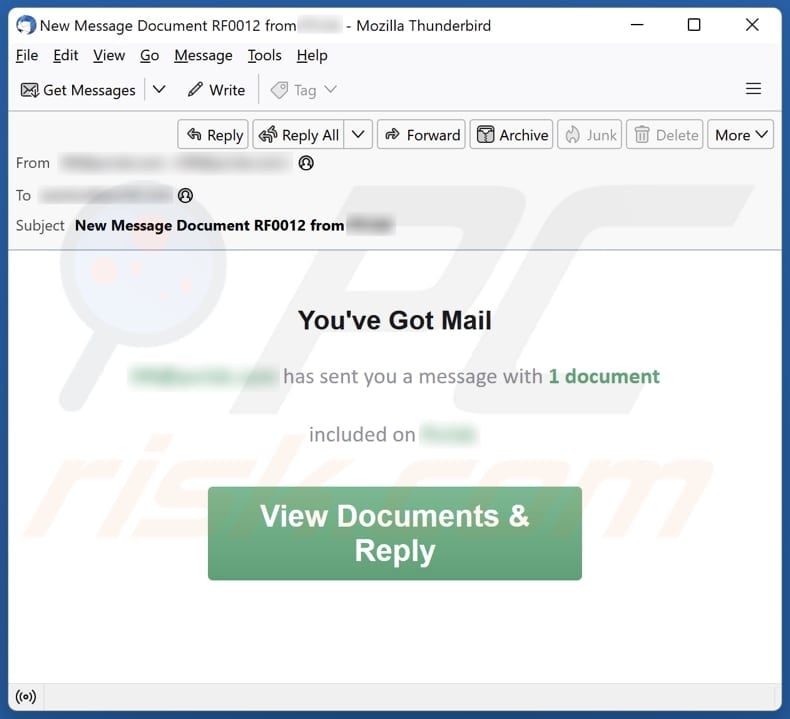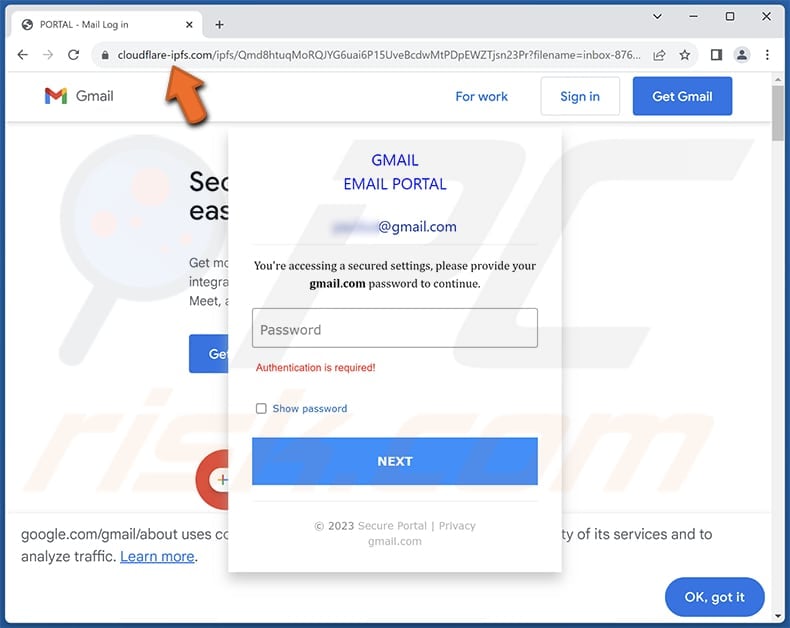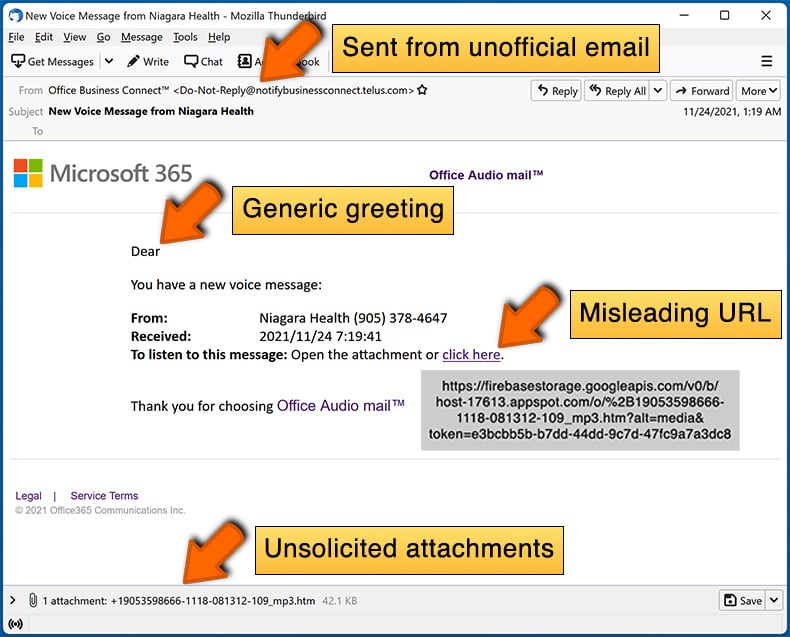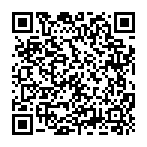How to identify scams like "You've Got Mail"
![]() Written by Tomas Meskauskas on (updated)
Written by Tomas Meskauskas on (updated)
What kind of scam is "You've Got Mail"?
We have identified this email as a fraudulent scheme orchestrated by scammers seeking to acquire personal information from recipients. These deceptive emails are widely recognized as phishing attempts. In this case, the scammers masquerade as an email service provider to extract information.

More about the "You've Got Mail" scam email
The phishing email appears to be designed to deceive recipients into thinking they have received a new message with an attached document. The email suggests a sense of urgency with the statement "You've Got Mail". The call to action is emphasized with the instruction to view documents and reply.
Clicking on the "View Documents & Reply" button within the email redirects users to a deceptive page that replicates the appearance of a legitimate email account login site. This fraudulent page is crafted to mirror the design associated with the recipient's email address. For example, if the recipient utilizes Gmail, they will encounter a fake page resembling the authentic Gmail login website.
The objective is to entice recipients to input their email account credentials (email addresses and passwords) on the phishing page. Subsequently, this entered information is transmitted to the scammers orchestrating the fraudulent scheme.
Upon acquiring pilfered email account login credentials, scammers leverage this information for a range of nefarious activities. For example, they access the victim's email account to harvest sensitive personal and financial details. Within the compromised inbox, scammers meticulously search for valuable data such as bank statements, login credentials for additional accounts, etc.
Furthermore, scammers frequently employ compromised email accounts to initiate phishing attacks on the victim's contacts. They send deceptive emails from the compromised account to deceive friends, family, or colleagues into revealing sensitive information or opening malicious pages.
In addition, scammers may utilize purloined email credentials to gain unauthorized entry to other online platforms where the victim maintains accounts. This exploits the common practice of reusing passwords across multiple services.
| Name | You've Got Mail Scam |
| Threat Type | Phishing, Scam, Social Engineering, Fraud |
| Fake Claim | Recipient has one unread message |
| Disguise | Letter from an email service provider |
| Symptoms | Unauthorized online purchases, changed online account passwords, identity theft, illegal access of the computer. |
| Distribution methods | Deceptive emails, rogue online pop-up ads, search engine poisoning techniques, misspelled domains. |
| Damage | Loss of sensitive private information, monetary loss, identity theft. |
| Malware Removal (Windows) | To eliminate possible malware infections, scan your computer with legitimate antivirus software. Our security researchers recommend using Combo Cleaner. |
Similar emails in general
Phishing emails are deceptive messages designed to trick recipients into divulging sensitive information, often by posing as trustworthy entities. These emails commonly employ urgent or enticing language, encouraging users to click on links or download attachments. Once victims interact with these elements, scammers can gain access to personal information.
It is important to mention that emails sent by cybercriminals can contain malicious files or links intended to trick users into infecting computers. A couple examples of other campaigns used to steal information via email are "DHL Shipping Invoice", "ACH-ELECTRONIC FUNDS TRANSFER", and "Netflix - Update Your Account Information".
How do spam campaigns infect computers?
Malicious emails from cybercriminals often come equipped with harmful attachments, ranging from executable files (.exe) and JavaScript files (.js) to documents (.doc, .pdf, and others). The embedded malware can be activated once users download and open these attachments.
Moreover, emails may include deceptive links, leading to fraudulent websites harboring malware. Clicking on these links can initiate the download and injection of malicious software, unbeknownst to the user.
It is essential to recognize that not every file poses an immediate threat upon opening. For example, malicious MS Office documents can compromise computers only when users enable macros (enable editing or content) within those documents.
How to avoid installation of malware?
Before opening links or files/attachments, authenticate the legitimacy of emails. Obtain software and files exclusively from official pages or reputable stores, avoiding the download of pirated software, cracking tools, or key generators. Prioritize reputable websites and refrain from clicking on pop-ups or ads on unfamiliar sites.
Ensure your operating system and software are up to date, including security solutions. Employ trustworthy antivirus and/or anti-malware software. If you have already opened malicious attachments, we recommend running a scan with Combo Cleaner Antivirus for Windows to automatically eliminate infiltrated malware.
Text presented in the "You've Got Mail" email letter:
Subject: New Message Document RF0012 from ********
You've Got Mail
******** has sent you a message with 1 document
included on ********.
View Documents & Reply
Phishing website promoted via this campaign:

Instant automatic malware removal:
Manual threat removal might be a lengthy and complicated process that requires advanced IT skills. Combo Cleaner is a professional automatic malware removal tool that is recommended to get rid of malware. Download it by clicking the button below:
▼ DOWNLOAD Combo Cleaner
By downloading any software listed on this website you agree to our Privacy Policy and Terms of Use. To use full-featured product, you have to purchase a license for Combo Cleaner. 7 days free trial available. Combo Cleaner is owned and operated by Rcs Lt, the parent company of PCRisk.com read more.
Quick menu:
- What is You've Got Mail phishing campaign?
- Types of malicious emails.
- How to spot a malicious email?
- What to do if you fell for an email scam?
Types of malicious emails:
![]() Phishing Emails
Phishing Emails
Most commonly, cybercriminals use deceptive emails to trick Internet users into giving away their sensitive private information, for example, login information for various online services, email accounts, or online banking information.
Such attacks are called phishing. In a phishing attack, cybercriminals usually send an email message with some popular service logo (for example, Microsoft, DHL, Amazon, Netflix), create urgency (wrong shipping address, expired password, etc.), and place a link which they hope their potential victims will click on.
After clicking the link presented in such email message, victims are redirected to a fake website that looks identical or extremely similar to the original one. Victims are then asked to enter their password, credit card details, or some other information that gets stolen by cybercriminals.
![]() Emails with Malicious Attachments
Emails with Malicious Attachments
Another popular attack vector is email spam with malicious attachments that infect users' computers with malware. Malicious attachments usually carry trojans that are capable of stealing passwords, banking information, and other sensitive information.
In such attacks, cybercriminals' main goal is to trick their potential victims into opening an infected email attachment. To achieve this goal, email messages usually talk about recently received invoices, faxes, or voice messages.
If a potential victim falls for the lure and opens the attachment, their computers get infected, and cybercriminals can collect a lot of sensitive information.
While it's a more complicated method to steal personal information (spam filters and antivirus programs usually detect such attempts), if successful, cybercriminals can get a much wider array of data and can collect information for a long period of time.
![]() Sextortion Emails
Sextortion Emails
This is a type of phishing. In this case, users receive an email claiming that a cybercriminal could access the webcam of the potential victim and has a video recording of one's masturbation.
To get rid of the video, victims are asked to pay a ransom (usually using Bitcoin or another cryptocurrency). Nevertheless, all of these claims are false - users who receive such emails should ignore and delete them.
How to spot a malicious email?
While cyber criminals try to make their lure emails look trustworthy, here are some things that you should look for when trying to spot a phishing email:
- Check the sender's ("from") email address: Hover your mouse over the "from" address and check if it's legitimate. For example, if you received an email from Microsoft, be sure to check if the email address is @microsoft.com and not something suspicious like @m1crosoft.com, @microsfot.com, @account-security-noreply.com, etc.
- Check for generic greetings: If the greeting in the email is "Dear user", "Dear @youremail.com", "Dear valued customer", this should raise suspiciousness. Most commonly, companies call you by your name. Lack of this information could signal a phishing attempt.
- Check the links in the email: Hover your mouse over the link presented in the email, if the link that appears seems suspicious, don't click it. For example, if you received an email from Microsoft and the link in the email shows that it will go to firebasestorage.googleapis.com/v0... you shouldn't trust it. It's best not to click any links in the emails but to visit the company website that sent you the email in the first place.
- Don't blindly trust email attachments: Most commonly, legitimate companies will ask you to log in to their website and to view any documents there; if you received an email with an attachment, it's a good idea to scan it with an antivirus application. Infected email attachments are a common attack vector used by cybercriminals.
To minimise the risk of opening phishing and malicious emails we recommend using Combo Cleaner Antivirus for Windows.
Example of a spam email:

What to do if you fell for an email scam?
- If you clicked on a link in a phishing email and entered your password - be sure to change your password as soon as possible. Usually, cybercriminals collect stolen credentials and then sell them to other groups that use them for malicious purposes. If you change your password in a timely manner, there's a chance that criminals won't have enough time to do any damage.
- If you entered your credit card information - contact your bank as soon as possible and explain the situation. There's a good chance that you will need to cancel your compromised credit card and get a new one.
- If you see any signs of identity theft - you should immediately contact the Federal Trade Commission. This institution will collect information about your situation and create a personal recovery plan.
- If you opened a malicious attachment - your computer is probably infected, you should scan it with a reputable antivirus application. For this purpose, we recommend using Combo Cleaner Antivirus for Windows.
- Help other Internet users - report phishing emails to Anti-Phishing Working Group, FBI’s Internet Crime Complaint Center, National Fraud Information Center and U.S. Department of Justice.
Frequently Asked Questions (FAQ)
Why did I receive this email?
Criminals dispatch identical messages to numerous recipients, anticipating that someone will be deceived. These spam emails lack any personalization.
I have provided my personal information when tricked by this email, what should I do?
If you have shared your email login credentials with scammers, act immediately. Change your password, monitor your accounts for any suspicious activity, and consider alerting your email provider about the situation.
I have downloaded and opened a malicious file attached to an email, is my computer infected?
If you have opened a malicious file from an email, the potential for computer infection varies depending on the type of file accessed. Certain file types, such as malicious executable files, are more likely to infect computers upon opening. However, documents, archives, and other files usually require further action.
I have read the email but did not open the attachment, is my computer infected?
Merely opening an email poses no risk. Computers are at risk upon opening links or files.
Will Combo Cleaner remove malware infections that were present in email attachment?
Combo Cleaner has the ability to eradicate nearly all known malicious software. It is noteworthy that advanced malware often conceals itself deeply within the system. Consequently, conducting a full system scan is required.


▼ Show Discussion